Night Fishing for Sea Trout
How to Catch a Sea Trout
Sea trout may be caught during
daylight hours in a falling river following a summer spate.
In such conditions sea-trout often behave much like salmon
and may be caught using similar tactics. Indeed, many sea
trout are caught on flies and lures intended for salmon.
But, following the spate, when the rivers have dropped back
to near summer level and again run clear, it is the hours of
darkness which present the best opportunities of catching
sea trout on the fly on British rivers.
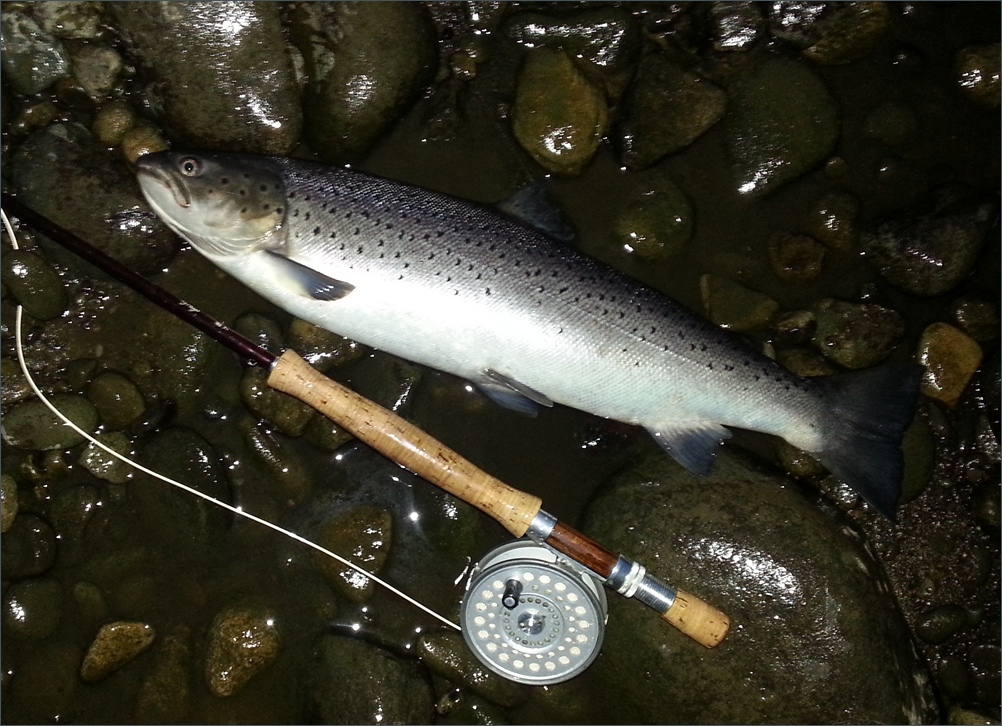
Tyne Sea Trout caught on the
fly at night
For those yet to experience the
great thrill of catching a sea trout on the fly in the dark,
I present here some tips on how to go about it with a
reasonable chance of success. Of course, success in sea
trout night fishing depends on a whole series of factors coming
together in the right way, at the right time and in the
right place. Not all of these factors are within our control
but the following guidelines might serve to optimise our
chances of success in catching sea trout at night on the fly.
Be in the Right Place at the Right Time
Generally, the best months on
British rivers for night sea trout fishing are June, July
and August. Peak runs and catches will vary from river to
river and with weather conditions throughout the season, but
the most propitious times can be judged fairly well by an
examination of recent seasons' catches. For rivers in
England and Wales the Environment Agency publishes yearly
salmon and sea trout catch statistics (view them at Recent
Salmon and Sea Trout catch Statistics ).
A thorough examination of these statistics will show the
most productive sea trout rivers in England and Wales and
the best months to fish them.
For example, if we look at
the 2016
Catch Statistics ,
we can see that the top ten sea trout rivers in England and
Wales in 2016 were as follows:
Tywi - 1743, Dyfi - 1696, Teifi
- 1543, Lune - 1461, Ribble - 1365, Tyne - 1214, Border Esk
- 1111, Wear - 976, Conwy - 962, Clwyd - 777.
The most productive months on
most were July and August. It is worth noting that, on many
sea trout rivers, the bigger fish often run earlier in the
season. So, if fishing in June, you may find sea trout of
larger than average size and they may also be more ready
takers of a fly (given suitable night conditions), while
later in the season, say in August, although there may be
more sea trout present in the river, they may be of a
smaller average size and generally not as fresh as the June
fish. On the other hand, there are fewer fishable hours
during the short June nights.
The 2016
E. A. report also
shows the salmon and sea trout catches on all English and
Welsh rivers for every season from 2006 to 2016. A study of
these statistics will pay dividends when deciding where and
when to go fishing for sea trout. Look not only at the total
yearly catches for each river but also at the reported rod
effort, number of days fished on each river, average weight
of the fish, the most productive months etc..
The table below shows the sea
trout catches on the major sea trout rivers in England and
Wales over a longer term, i.e. the years 2000 to 2016. While
the long term trend is generally downward, improved sea
trout catches in recent years on one or two of the English
rivers, notably the west coast rivers Lune and Ribble, may
give cause for cautious optimism.
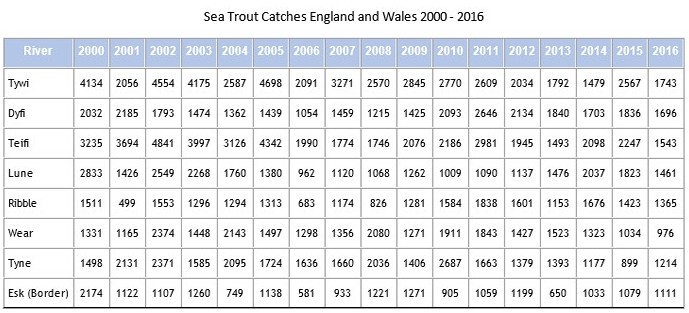
If no national statistics are
available, for example for many Scottish rivers, the fishery
you intend to fish, be it a privately let beat or
club/association water, should have catch records for you to
consider when planning your sea trout fishing trip.
Only the top rivers in England
and Wales are mentioned above. Sea trout may be caught on
many more, both north and south of the border. The River
Spey, in
particular, is one of the very best sea trout rivers in the
British Isles. The Spey has, historically, been one of the
most productive sea trout rivers in the UK, with a ten year
average annual catch (1992 to 2001) of 4,590 rod-caught sea
trout. By comparison, only the Rivers Tywi and Teifi in
Wales have caught more fish. Catches over recent seasons
have been lower, in line with the general downward trend
throughout the country. The 2016 declared rod catch for sea
trout on the River Spey was 1,318, which was a 39% reduction
on the 2,175 caught in 2015. The 2017 season, however, has
shown a vast improvement, with the Kinchurdy beat alone
ending the season with a catch of 340 sea trout, three times
the number recorded in 2016. The two major Spey angling
associations at Grantown and Abernethy have also shown a
significant improvement on the 2016 catch, with productive
night fishing from as early as mid-May. The total catch of
sea trout recorded for the River Spey for the 2017 season
was 2293 . The table below shows Spey sea trout catches in
recent years (from 2003 to 2017).
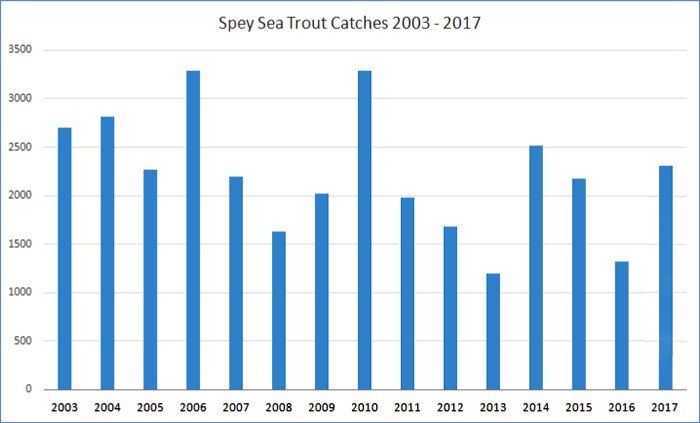
For a graph showing catches
for the period 1952 to 2011, see Spey
Sea Trout Catches .
It should be noted that the best months for sea trout night
fishing on the Spey are June and July, with June generally
being the more productive month. Other Scottish sea trout
rivers worthy of consideration are the Deveron, Ugie, Ythan,
South Esk, Earn, Allan, Nith,
Annan and Border Esk (Scotland and England),
to name but a few.
Having reviewed the available
catch statistics, you now need to arrange access to your
chosen river. This might be done through booking a private
beat or by either joining or buying a visitor's permit to
fish on the water managed by one of the many angling clubs
and associations throughout the country. For some ideas on
accessible fishing clubs and associations with good sea
trout fishing, see Sea
Trout Angling Associations
For more information see British
Sea Trout Rivers
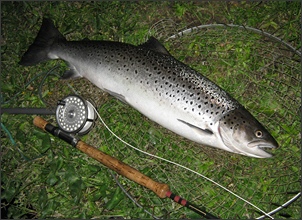 |
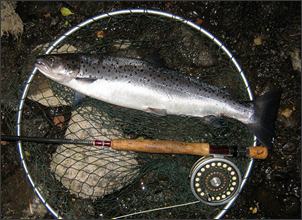 |
|
Sea trout caught on the fly at
night on the Grantown Association water of the River
Spey |
Pray for a Low Clear River
Given the option of flexibility
in the timing of your sea trout fishing trip, be sure to go
when the river has dropped, cleared and settled to a fairly
steady low level, generally no more than about six inches
above summer low level (the fishable height will vary from
river to river - the main essential for night fishing is that the river should
be running clear) ideally several days after a summer spate
which will have cleaned out and freshened the river and
hopefully brought in a run of fresh sea trout. Hope also
that the weather during your visit will remain on the dry
side, so that the river level will remain at that crucial
steady low level and continue to run clear.
Hope for Favourable Weather
We all have to take what comes
weather-wise but sea trout success often depends very much
on nocturnal conditions. Generally we will look for settled
weather with temperatures remaining in double figures
(centigrade) throughout the night, with a good bit of cloud
cover. A little rain now and again will do no harm, provided
that it does not cause the river to rise and colour. The
chances of catching sea trout at night on a river running
with any colour are very low. You may catch sea trout during
the day, and maybe at dusk, in coloured water but, for
successful night fishing with the fly, the river should be
running as clear as crystal. Sea trout will generally be
most active, and most catchable, in the first hour or two of
darkness, rarely before darkness has fallen. On mild nights,
they may be caught throughout the night. If the night turns
cold, you may have to work harder for a fish.
Select a Suitable Stretch of River to Fish at Night
On arriving at your chosen
beat, hoping that recent weather conditions have allowed the
river to drop and settle to a steady low level, you should
devote a good part of your first day to walking the beat,
discovering where you may safely enter and exit the river
(look out for well trodden entry and exit points for
clues to the most popular fishing spots, also for popular
riverside parking spots where the road runs near the river),
where you may wade safely etc., but, most importantly,
trying to identify places where the sea trout are likely to
take a fly at night. In the absence of an experienced local
advisor, this may not be easy. On small rivers ( I am
thinking here of rivers like the Cumbrian Esk, Cothi,
Endrick, Dulnain, Liddel etc.), it may be
possible, even necessary, to concentrate on the main pools,
fishing them quietly, thoroughly and methodically from head
to tail, as these pools may be where the sea trout are to be
found at night. In general though, particularly on a medium
to large river (for example the Spey, Earn, Dee, Deveron,
Border Esk, Nith, Towy,
Wear, Lune etc.), once it is properly dark, I would not
concentrate my efforts on the deeper, slower parts of a
pool. Nor would I favour the rougher streams you will often
find at the head of a pool (often among the most productive
daytime spots for brown trout and salmon but not so much, in
my experience, for sea trout at night).
Instead, I would
hope to find places where the river shallows and/or narrows,
causing the flow to quicken, but with a fairly smooth
surface, i.e. streamy but not rough, broken or turbulent
water. This kind of water will generally be found towards
a pool tail but not only at the tail. The most productive
areas may often be found where the stream quickens within a pool,
i.e. where a shallower river bed separates two deeper areas
within a pool,
or on the smoother, swifter glides between pools. While sea
trout
might feel over-exposed if lying in such shallow streams
during daylight hours, I suspect that the nature of the flow
in these gentle streams, together with favourable
atmospheric conditions, allow the sea trout to optimise
their intake of oxygen with the minimum of effort. Secure
under the cover of darkness, they are now comfortable, unstressed and uninhibited - in their element, we
might say - strong, vital and invigorated, alert and full of beans,
particularly if fresh off the tide, and
incautious enough at times to chase and take a carefully
presented fly. It might be added that the ideal sea trout
stream should be in close proximity to deeper water, above
or below, to which the sea trout might retire at any time
during the night for reasons of safety or comfort, and in
which they are likely, at times of low water, to spend most
of their daylight hours.
Look out
also for areas of shingle, exposed in times of low water, on
one side where the river narrows. Here, sea trout will often
lie in the main flow towards the far bank, particularly if
there is good tree cover on that bank. Google Earth is a
great resource for identifying likely places, such as
those shown in the images below. Casting a fly from the
shingle bank (the lighter areas) to the deeper water under
the trees on the far bank will often prove worthwhile.
Sea Trout Taking Places
The lighter coloured
riverside areas shown on the two Google Earth aerial
photographs below are shingle banks exposed at times of low
water. The flow of the river quickens at these points where
the river narrows, with the main flow following the deeper
channel, which is usually near the far bank. Sea trout will
often lie here.
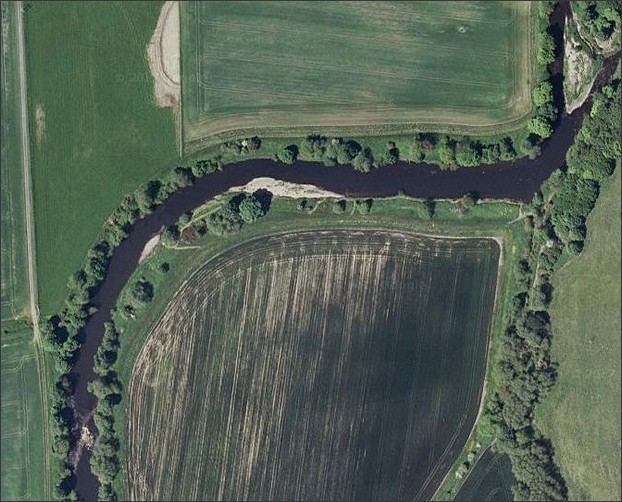
Sea Trout Water-Example 1
Note the well worn paths anglers have taken when entering
and exiting the pool above (the flow here is left to right)
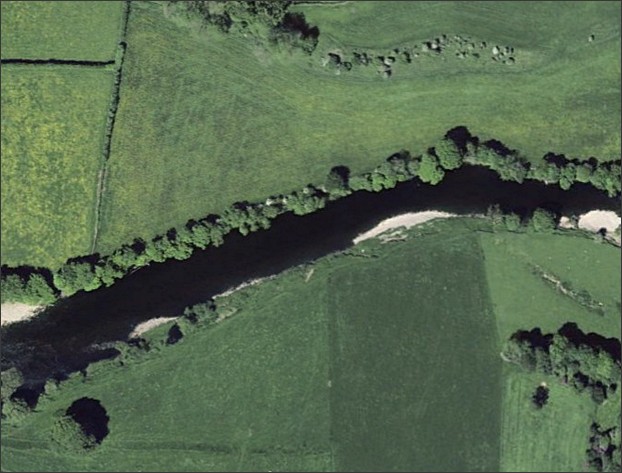
Sea Trout Water-Example 2 A
very similar pool to that shown above (the flow here is
right to left)
The shingle banks shown
above are often formed on the inside of a gentle bend in the
river with the heaviest flow on the outside of the bend. In
some straighter sections of the river, the flow may quicken
in areas where the river bed shallows fairly uniformly
across the width of the river, between two pools or within a
single longer pool. As mentioned above but worth repeating,
these shallow faster (though not rough)
streams - ideally situated immediately above or below deeper
water which offers sanctuary to the sea trout during the
daytime or when they become inactive at night - are often
worth concentrating on, as are the pool tails, where the
flow again quickens over a gradually shallowing river bed.
Sea Trout Night Time Fly
Fishing Water
A few likely looking spots for
sea trout night fishing are shown below on a variety of
rivers large and small throughout the UK
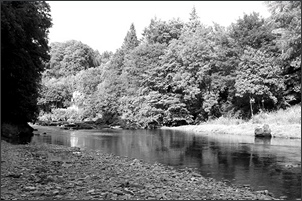 |
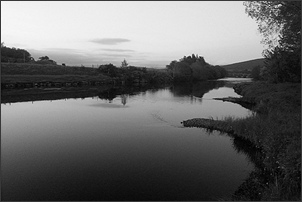 |
| Border Esk |
River Spey |
| |
|
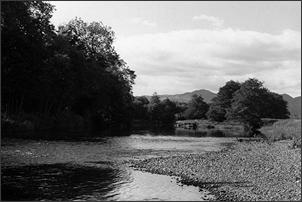 |
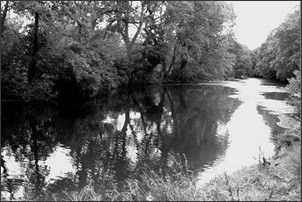 |
| River Earn |
Cumbrian Esk |
| |
|
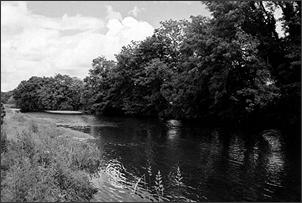 |
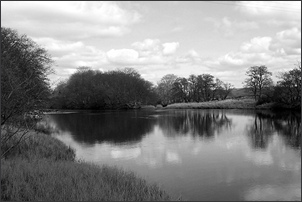 |
| River Towy |
River Spey |
| |
|
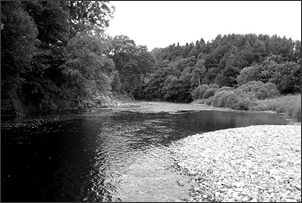 |
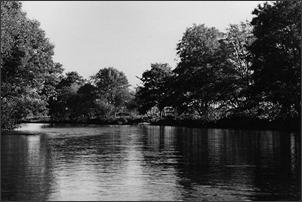 |
| River Liddel |
River Earn |
| |
|
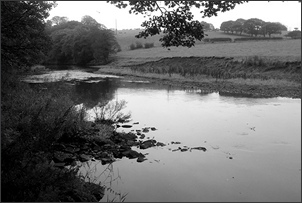 |
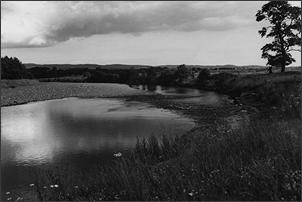 |
| River Wear |
River Nith |
| |
|
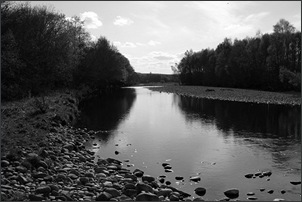 |
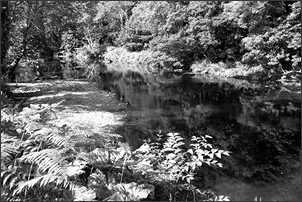 |
| River
Dulnain |
River Coquet |
| |
|
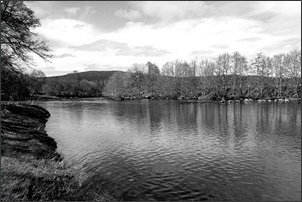 |
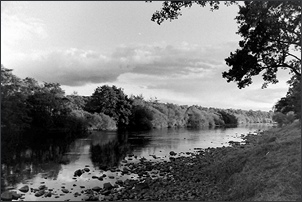 |
| River Spey |
Border Esk |
On mild nights, I have found
that sea trout will often move, from the sanctuary of their
deeper daytime lies, into such streams and glides, sometimes
little more than a foot deep and, more importantly, will be
prepared to take a fly in them. Another benefit of the
quickening stream, in a river running at low summer level,
is that it allows the fly to swing round at a good pace
without the need for much, if any, hand lining. Stealth, of
course, is essential in such shallow clear streams, which
brings us to the next point.
Don't Begin Fishing Before Dark
In the low clear water of our
summer rivers, sea trout tend to hide away during the day,
seeking sanctuary in the deeper pools. Other than in spate
conditions, they are very wary, easily spooked and very
difficult to catch during daylight hours. At night, they
will often emerge from their daytime lies, to revel in the
safety and security of the darkness. Once it is dark enough,
they may move around within the pools, or run into the next
pool upstream. They may move into shallower streams,
sometimes showing their presence by leaping in the air or
making bow waves in the pool tails. This activity is more
likely, and may last for a longer period, on mild nights.
Generally, sea trout are most active during the first hour
or two of darkness. It is then that we have our best chance
of persuading them to take our flies. But not before it is
properly dark. To begin before the riverside greens have
turned to grey, though tempting, is likely to put an end to
your sport before it has begun. Sea trout are less wary at
night than during the day, but they may easily be put off if
the angler betrays his presence by careless casting or
wading. Fish as stealthily as you would in daylight. Move
slowly and quietly, keep off the skyline and seek background
tree cover, especially on bright nights. If there is a moon,
try not to fish with it at your back.
Tackle and Tactics
Sea Trout Fly Fishing at Night
Keep it simple! Unless you are
fishing a very small river, where a 9 foot rod may suffice,
I would recommend a rod of ten feet, fitted with a short
butt extension of up to two inches long. This keeps the
reel, which should be large enough to accommodate the fly
line plus 100 yards of backing, away from clothing when
fishing and playing fish. The rod should not be stiff and
poker-like but should have a middle-to-tip or "through" action, flexing through much of its length when casting and
playing fish. It should be rated for a number seven line but
used in conjunction with a number eight line. This slight
overloading will make it easier to feel what is going on in
the dark and load the rod more easily for short to medium
casts. Even on large rivers, you will rarely need to cast
more than about twenty yards.
For most night fishing in
shallow water, i.e. anything from about one to five feet in
depth, I would recommend a floating line, either double
tapered or weight forward. To this I would attach a leader
consisting of eight to ten feet of 8lb or 10lb Maxima
Chameleon, treated with an application of fuller's earth
mixture to allow it to sink more readily. I would suggest a
single fly or lure. You might begin with a single fly in
size 10 or 8 and perhaps change to a longer lure later in
the night, maybe a slim stainless steel needle tube fly
dressed on a tube of 25mm to 35mm in length.
|
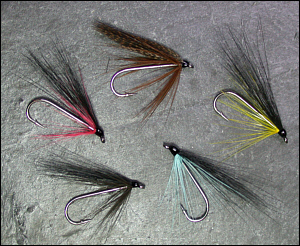 |
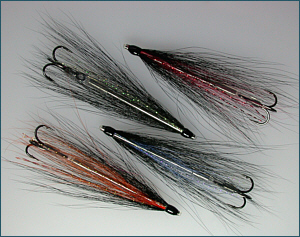 |
|
Sea Trout Singles |
Sea Trout Needle
Tubes |
Single, double and treble hooks
may be used effectively for sea trout. I have tended to use
dressed singles for smaller flies, i.e. flies up to around
an inch long such as the size eight singles shown above
left, while my longer lures have been dressed on needles or
needle tubes armed with small trebles, usually size 14, as
shown above right. Both singles and small trebles tend to
hook fish equally well and both are fairly easily removed
when releasing fish. Increasing regulation, however, often
now restricts the use of treble hooks for salmon and sea
trout fishing. A good option, then, is to arm our sea trout
tube flies with single hooks, as in the examples shown
below, which are dressed on 15mm long needle tubes (1.5mm
diameter) and armed with size 6 Drennan specimen single
hooks. Note that setting the single hook with point
uppermost will add to the stability of a tube fly, since a
single (or double) undressed hook will swim naturally with
hook points up.
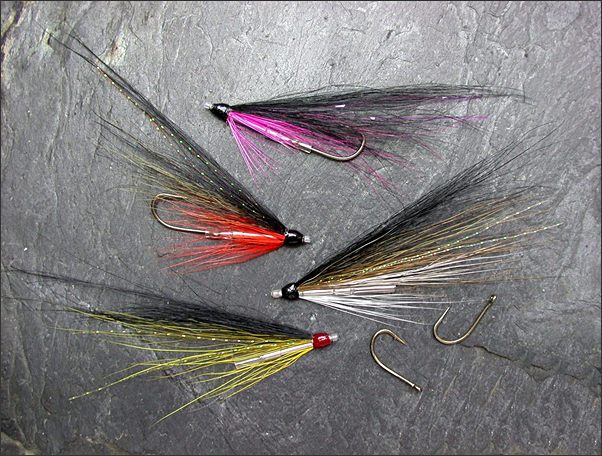
Sea Trout "Tinglers"
(needle tube flies armed with single hooks)
Lure size may depend to an
extent on the river level, temperature, degree of darkness,
distance from the sea, time of night, time of year etc.. A
high river and a cold or very dark night, for example, might
require a longer lure. In addition to a box of singles, most
dressed on size 8 hooks, I normally carry a selection of
needle tube flies, dressed on tubes of 10 to 35mm in length,
with a total wing length of 1.25 inches to 3 inches. The colour of the fly is of little
importance, as sea trout cannot distinguish colour at night
any more than we can. Black and silver is as good as
anything, perhaps with a dash of white or other lighter
shade just to provide a little contrast. A normal cast, even
on our larger sea trout rivers, need be no more than about
twenty yards, i.e. a leader of up to 10 feet, 30 feet of fly
line outside rod tip when casting, 10 feet of rod, plus 10
to 15 feet of line retrieved during or at the end of fly's swing, to
be shot again on the forward cast = a cast of over 60 feet
(twenty yards). Often a much shorter cast will suffice.
Having retrieved the few yards
of fly line shot on the previous cast, the next cast should
be made, with no false casting, to a point near the far bank
at an angle varying from 45 to 90 degrees to the flow. You
will normally be fishing from the shallow side of the river
casting to deeper water on the far side. Where there is
sufficient flow to work the flies, the line and fly may be
allowed simply to swing round to the dangle (the rod angled
slightly above the horizontal with the fly line trapped
between the rod handle and the index finger of the casting
hand) before the few yards of shooting fly line are
retrieved and the line recast. The speed of the fly may be
varied, often to good effect, by casting at varying angles
and/or performing a retrieve of varying speeds by pulling in
line with the non casting hand via the index finger of the
casting hand, which will be used to trap the line
momentarily, to set the hook when a fish takes. The whole
pool, stream or glide can be covered in this way by moving,
often wading, slowly and carefully downstream, casting as
you go.
You will need a pair of chest
waders fitted with studded or felt soles. You will also need
a landing net, which can be carried comfortably while
fishing and employed conveniently, while wading in the
river, when a fish is caught. A "gye" net of 24 inch
diameter, slung over the back, is ideal. A good waterproof
wading jacket is essential, as is hat and warm clothing,
particularly if you intend to fish late into the night.
Another essential accessory is a torch for making your way
to and from the river and for changing flies by the
riverside. Head torches are now popular but their use should
be kept to a minimum and care should be taken to avoid the
torch beam shining on the river. Carry a spool or two of
nylon, a handy pair of scissors or snips for changing flies,
and forceps for removing hooks, perhaps a camera for a quick
shot of the catch and a mobile phone. Food and a warm drink
to taste complete the list of night fishing essentials. Oh, nearly
forgot the midgie repellent .... don't leave home without it
and apply it liberally on leaving the car.
Tight lines,
John Gray
For more sound advice on
setting out on your first sea trout fishing expedition, see
this article by the late Dave Wallbridge: Starting
Out for Sea Trout
|